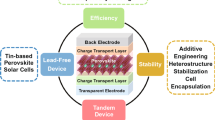Abstract
The combination of the photoanode fabrication condition, electrolyte type and light source effect on dye-sensitized solar cell (DSSC) performance were investigated. Three different photoanodes (C1, C2 and C3) were used with different fabrication conditions with two different redox concentration electrolytes (30 and 50 mM) for each photoanode. For these six different combinations, DSSC performances were obtained for 12 different situations using two different light sources, AM 1.5 simulated and ultraviolet (UV-365 nm) illumination. It was obtained that the HI30 electrolyte has higher efficiency for UV illumination and the AN50 electrolyte has higher efficiency for AM1.5 simulated illumination. It was also obtained that the C2 cell with double layer immersed in dye solution has higher efficiency for both two illumination types and two electrolytes.





Similar content being viewed by others
References
Sauvage F, Di Fonzo F, Li Bassi A, Casari C S, Russo V, Divitini G et al 2010 Nano Lett. 10 2562
Akhtar M S, Khan M A, Jeon M S and Yang O-B 2008 Electrochim. Acta 53 7869
Ramasamy E and Lee J 2010 J. Phys. Chem. C 114 22032
O’Regan B and Grätzel M 1991 Nature 353 737
Grätzel M 2001 Nature 414 338
Kusumawati Y, Koussi-Daoud S and Pauporté T 2016 J. Photochem. Photobiol. A Chem. 329 54
Wang P, Klein C, Humphry-Baker R, Zakeeruddin S M and Grätzel M 2005 J. Am. Chem. Soc. 127 808
Baglio V, Girolamo M, Antonucci V and Aricò A S 2011 Int. J. Electrochem. Sci. 6 3375
Gledhill S E, Scott B and Gregg B A 2005 J. Mater. Res. 20 3167
Su’ait M S, Rahman M Y A and Ahmad A 2015 Sol. Energy 115 452
Le Bahers T, Labat F, Pauporté T and Ciofini I 2010 Phys. Chem. Chem. Phys. 12 14710
Dai Q, Menzies D B, MacFarlane D R, Batten S R, Forsyth S, Spiccia L et al 2006 Comptes. Rendus. Chim. 9 617
Yildiz Z K, Atilgan A, Atli A, Özel K, Altinkaya C and Yildiz A 2019 J. Photochem. Photobiol. A Chem. 368 23
Atli A, Atilgan A and Yildiz A 2018 Sol. Energy 173 752
Chen L, Li X, Wang Y, Gao C, Zhang H and Zhao B 2014 J. Power Sources 272 886
Pradhan A, Sai Kiran M, Kapil G, Hayase S and Pandey S S 2019 Sol. Energy Mater. Sol Cells 195 122
Zhang H, He B and Tang Q 2016 Mater. Chem. Phys. 173 340
Wu W Q, Liao J Y, Chen H Y, Yu X Y, Su C Y and Kuang D B 2012 J. Mater. Chem. 22 18057
Hafez H S, Shenouda S S and Fadel M 2018 Spectrochim. Acta Part A Mol. Biomol. Spectrosc. 192 23
Çakar S, Güy N, Özacar M and Fındık F 2016 Electrochim. Acta 209 407
Xia J, Masaki N, Jiang K and Yanagida S 2007 J. Photochem. Photobiol. A Chem. 188 120
dos Santos Junior G A and Nogueira A F 2018 J. Solid State Electrochem. 22 1591
Bari D, Wrachien N, Meneghesso G, Andrea C, Tagliaferro R, Brown T M et al 2013 in IEEE Int. Reliab. Phys. Symp. p 4B.3.1
Ko Y-S, Kim M-H and Kwon Y-U 2008 Bull. Korean Chem. Soc. 29 463
Nazeeruddin M K, Kay A, Rodicio I, Humphry-Baker R, Mueller E, Liska P et al 1993 J. Am. Chem. Soc. 115 6382
Huang S Y, Schlichthörl G, Nozik A J, Grätzel M and Frank A J 1997 J. Phys. Chem. B 101 2576
Amirnasr M, Nazeeruddin M K and Grätzel M 2000 Thermochim. Acta 348 105
Acknowledgements
This study was supported by Düzce University Scientific Research Project (Project Number 2019.05.02.1026). Also we are thankful to Dr Abdullah Yıldız and his research groups for experimental support.
Author information
Authors and Affiliations
Corresponding author
Rights and permissions
Springer Nature or its licensor (e.g. a society or other partner) holds exclusive rights to this article under a publishing agreement with the author(s) or other rightsholder(s); author self-archiving of the accepted manuscript version of this article is solely governed by the terms of such publishing agreement and applicable law.
About this article
Cite this article
Orhan, E., Gökçen, M. & Taran, S. Effect of the photoanode fabrication condition, electrolyte type and illumination type on dye-sensitized solar cells performance. Bull Mater Sci 44, 60 (2021). https://doi.org/10.1007/s12034-020-02347-5
Received:
Accepted:
Published:
DOI: https://doi.org/10.1007/s12034-020-02347-5




